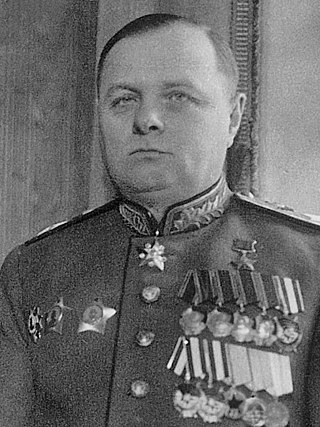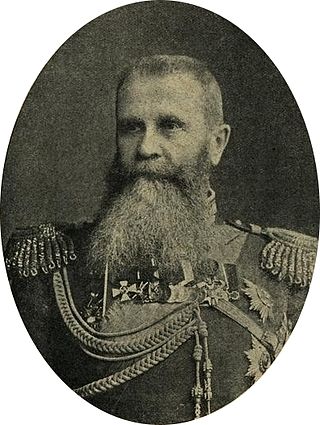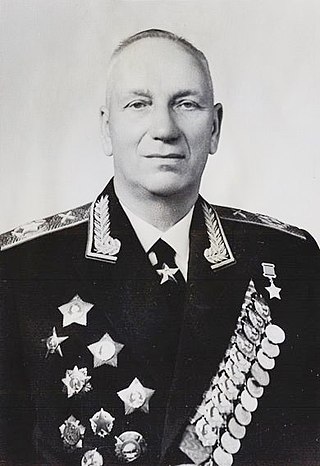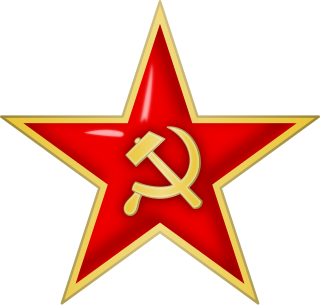Marshal of the Soviet Union was the second-highest military rank of the Soviet Union. Joseph Stalin wore the uniform and insignia of Marshal after World War II.

Ivan Stepanovich Konev was a Soviet general and Marshal of the Soviet Union who led Red Army forces on the Eastern Front during World War II, responsible for taking much of Axis-occupied Eastern Europe.

Kirill Afanasievich Meretskov was a Soviet military commander. Having joined the Communist Party in 1917, he served in the Red Army from 1920. During the Winter War of 1939–1940 against Finland, he had the task of penetrating the Mannerheim Line as commander of the 7th Army. He was awarded the title of Hero of the Soviet Union shortly afterwards.

Mikhail Vasilyevich Alekseyev was an Imperial Russian Army general during World War I and the Russian Civil War. Between 1915 and 1917 he served as Tsar Nicholas II's Chief of Staff of the Stavka, and after the February Revolution, was its commander-in-chief under the Russian Provisional Government from March to May 1917. He later played a principal role in founding the Volunteer Army in the Russian Civil War and died in 1918 of heart failure while fighting the Bolsheviks in the Volga region.

The Minister of Defence of the Soviet Union refers to the head of the Ministry of Defence who was responsible for defence of the socialist/communist Russian Soviet Federative Socialist Republic from 1917 to 1922 and the Soviet Union from 1922 to 1992.

Yevgeny Ivanovich Shaposhnikov was a Soviet and Russian military leader and business figure. He was awarded the rank of Marshal of Aviation in 1991. He was the final Minister of Defense of the Soviet Union.

Nikolai Iudovich Ivanov was a Russian artillery general in the Imperial Russian Army. In July 1914, Ivanov was given command of four armies in the Southwestern Front against the Austro-Hungarian army, winning a major battle of Galicia. During the Russian Revolution of March 1917, Tsar Nicholas II ordered Ivanov to suppress the revolutionaries but as promised reinforcements failed to come to his aid, he canceled the aborted mission. In 1917, he retired but a year later took command of the White Army. In 1919, Ivanov died of typhus in Southern Russia.

Nikolai Nikolayevich Voronov was a Soviet military leader, chief marshal of the artillery (1944), and Hero of the Soviet Union. He was commander of artillery forces of the Red Army from 1941 until 1950. Voronov commanded the Soviet artillery during the Battle of Stalingrad and was the Stavka representative to various fronts during the Siege of Leningrad and the Battle of Kursk. He also fought in the Russian Civil War, the Polish-Soviet War and the Battle of Khalkin Gol, as well as serving as an advisor to the Spanish Republican Army during the Spanish Civil War.

Nikolai Nikolayevich Yanushkevich was a Russian general who served as the chief of staff of the general headquarters (stavka) of the Imperial Russian Army from August 1914 to September 1915.

The Romanian Front was an army group level command of the Imperial Russian Army and the Romanian Army during the First World War.

Nikolai Nikolaevich Vashugin was a Soviet general and a political officer.

The Medal "For the Defence of Leningrad" was a World War II campaign medal of the Soviet Union established on December 22, 1942 by decree of the Presidium of the Supreme Soviet of the USSR to recognise the valour and hard work of the Soviet civilian and military defenders of Leningrad during the 872-day siege of the city by the German armed forces between September 8, 1941 and January 27, 1944. The medal's statute was later amended by Resolution of the Presidium of the Supreme Soviet on March 8, 1945. and again one last time on July 18, 1980 by decree of the Presidium of the Supreme Soviet of the USSR № 2523-X.

The M. V. Frunze Military Academy, or in full the Military Order of Lenin and the October Revolution, Red Banner, Order of Suvorov Academy in the name of M. V. Frunze, was a military academy of the Soviet and later the Russian Armed Forces.
Between 1943 and 1955, the ranks and insignia of the Soviet Armed Forces were characterised by a number of changes, including the reintroduction of rank insignia badges and the adoption of a number of higher ranks.

During the Russian Civil War of 1917-1923, a number of former Tsarist officers joined the Red Army, either voluntarily or as a result of coercion. This list includes officers of the Imperial Russian Army commissioned before 1917 who joined the Bolsheviks as commanders or as military specialists. For former Tsarist NCOs promoted under the Soviets, see Mustang.
The 376th Rifle Division was raised in 1941 as an infantry division of the Red Army, and served for the duration of the Great Patriotic War in that role. It began forming in August 1941 in the Siberian Military District. It followed a very similar combat path to that of the 374th Rifle Division. It joined the fighting front in December with the new 59th Army along the Volkhov River and it continued to serve in the battles near Leningrad until early 1944. The division took horrendous casualties in the combat to create and hold open a passage to the 2nd Shock Army during the Lyuban Offensive and was itself partly or fully encircled at several times during this dismal fighting. The division finally left this region as it advanced during the Leningrad–Novgorod Offensive in January 1944 and in July won a battle honor in the liberation of Pskov, while its 1250th Rifle Regiment was awarded the Order of the Red Banner. In October the 376th as a whole would also receive the Red Banner for its part in the liberation of Riga. The division ended the war in Latvia, helping to contain and reduce the German forces trapped in the Courland Pocket, and was reorganized as a rifle brigade shortly thereafter.

The Stavka of the Supreme Commander was the supreme headquarters of the Russian Imperial Army in the field during World War I until the demobilization of the army in March 1918.
The Supreme Commander–in–Chief is the supreme commander of the armed forces of a state, usually in wartime and sometimes in peacetime.

The Stavka of the Supreme High Command was an extraordinary body of the highest military command, exercising strategic leadership of the Soviet Armed Forces during the Great Patriotic War.
The Headquarters of the Supreme Commander-in-Chief is the highest command and control body for the troops and individual branches of the Armed Forces of Ukraine, as well as law enforcement services and agencies of Ukraine, which are part of the Armed Forces, formed by decree of the President of Ukraine No. 72/2022 dated February 24, 2022 in response to the Russian invasion of Ukraine on that day.

















